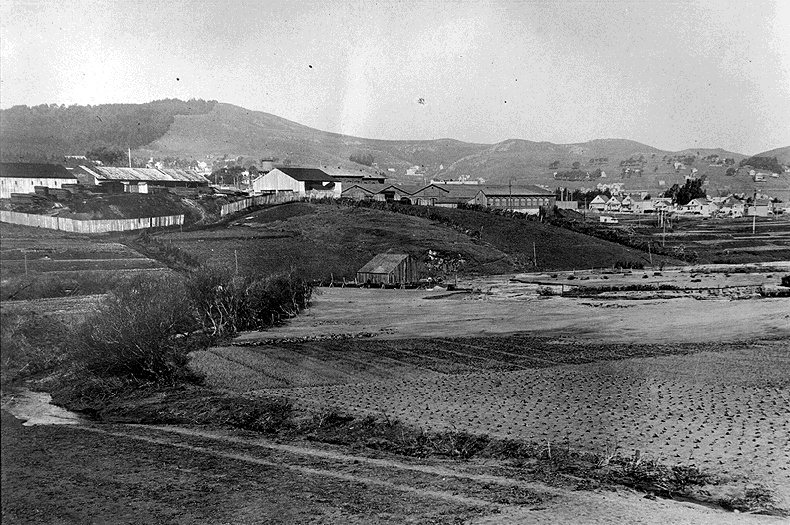falling in love with land
June 2nd, 2010 by brookephoto: View of Islais Creek in 1918, disappearing into culvert not far from the Geneva Car barn. Sutro Forest covers part of Mt. Davidson in upper left. From the Greg Gaar Collection, San Francisco, CA
It is wonderful feeling to begin forging a relationship with a piece of land. In our case it is a stretch of soft earth running the length of a city block, couched by the fenced backyards of almost 40 houses. Going out to Cotter street is not yet going to a garden or to a farm, but like going to land. Its long and wild. There is no infrastructure, no water main, no electricity, no structures, no bathroom, no shelter except the dappled shade of a lone eucalyptus. In the mornings, the fog lays low and the Outer-Mission feels like its lodged in a perennial winter. At mid day strong, unobstructed sun warms beats down. Then, like clockwork, around four o’clock, wind kicks up from the south. Some days the fog and wind team up together and stay all day. After a days work, I do not feel like I have been in the city but rather that I have been in the elements. I leave Cotter Street windswept, with a sunburn and chapped lips, and I emerge two blocks away onto Mission.
The ground is still spongy from winter rains, confirming what many neighbors have told us – a river runs under our feet. Cayuga Creek, which hasn’t been day-lighted since the early 1900’s, makes its presence known. Apparently,some winters, in the low spots, the water table rises a foot above the saturated ground, flooding neighbors basements and backyards. Water makes this land compelling. One neighbor has offered to help us dig a well and I am so excited about the possibility of irrigating with our own water. I feel even more endeared to this place after a trip to the SF History floor at the Public Library. Old maps from 1915 show that vast tracts of allotment vegetable gardens stretched across this neighborhood. Probably because of the high water table, and alluvial soil, turn-of-the century SF residents recognized that this was especially fertile ground. I enjoy the feeling of connection to people who lived here a century ago. One of the neighbors we have met, Lena, is from this place then. She must be in her late nineties and says, regarding her friends and community, that she is the last one left. She remembers when most families grew vegetables and some sold them to produce markets.
The weeds are a soft jungle. Pastel fireworks of radish flowers explode out of a fennel cloud cover. Above that, drying wild oats sway making a soft clatter. Sometimes I hear the small scurrying of furry residents in the thicket. This land was in a particular state of grace before we started into it with our weed-wackers and roto-tiller. Even as a determined gardener committed to creating diverse food-producing gardens around the city, it feels like a transgression to plow into this vision of wild spring fertility with spinning blades. The aesthetic of land is subjective of course; multiple neighbors have mentioned that they are happy that we are finally abating the eyesore and the fire hazard. On one hand, our tools leave the land looking razed stubbled and scratched. On the other hand, this state of transition is a vision of potential. It is the image of the first step of cultivation. The first stroke of agricultural care and craft. All good farming and gardening is finding the meeting place between attention to the natural features and habitat of land, and the activity of coaxing your own imaginations, visions and desires from it.


Wonderful piece. It’s inspiring to read about your journey cultivating a relationship with this wild space as it is in the present, as well as its deep history.
[…] This post was mentioned on Twitter by gather + hunt, Brie Mazurek. Brie Mazurek said: Gorgeous piece about cultivating the wilds of SF by Brooke Budner at Little City Gardens http://bit.ly/aqKLBW […]